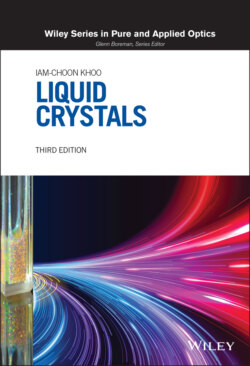Читать книгу Liquid Crystals - Iam-Choon Khoo - Страница 33
2.1.3. Long‐ and Short‐range Order
ОглавлениеThe order parameter, defined by Eq. (2.2) and its variants such as Eqs. (2.4) and (2.8), is an average over the whole system and therefore provides a measure of the long‐range orientation order. The smaller the fluctuation of the molecular axis from the director axis orientation direction, the closer the magnitude of S is to unity. In a perfectly aligned liquid crystal, as in other crystalline materials, 〈cos2 θ〉 = 1 and S = 1; on the other hand, in a perfectly random system, such as ordinary liquids or the isotropic phase of liquid crystals, 〈cos2 θ〉 = and S = 0.
An important distinction between liquid crystals and ordinary anisotropic or isotropic liquids is that, in the isotropic phase, there could exist a so‐called short‐range order [1, 2]; that is, molecules within a short distance of one another are correlated by intermolecular interactions [4]. These molecular interactions may be viewed as remnants of those existing in the nematic phase. Clearly, the closer the isotropic liquid crystal is to the phase transition temperature, the more pronounced the short‐range order and its manifestations in many physical parameters will be. Short‐range order in the isotropic phase gives rise to interesting critical behavior in the response of the liquid crystals to externally applied fields (electric, magnetic, and optical) (see Section 2.3.2).
As pointed out at the beginning of this chapter, the physical and optical properties of liquid crystals may be roughly classified into two types: one pertaining to the ordered phase, characterized by long‐range order and crystalline‐like physical properties; the other pertaining to the so‐called disordered phase, where a short‐range order exists. All these order parameters show critical dependences as the temperature approaches the phase transition temperature Tc from the respective directions.
